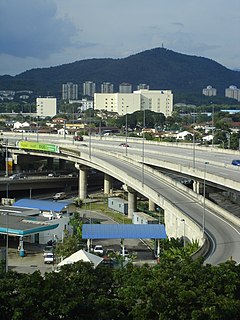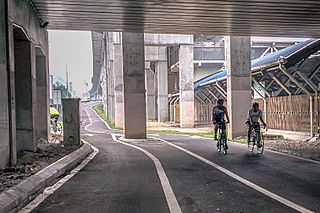
Kuala Lumpur, officially the Federal Territory of Kuala Lumpur and colloquially referred to as KL, is a federal territory and the capital city of Malaysia. It is the largest city in Malaysia, covering an area of 243 km2 (94 sq mi) with an estimated population of 1.73 million as of 2016. Greater Kuala Lumpur, also known as the Klang Valley, is an urban agglomeration of 7.564 million people as of 2018. It is among the fastest growing metropolitan regions in Southeast Asia, in both population and economic development.

Transportation in Malaysia started to develop during British colonial rule, and the country's transport network is now diverse and developed. Malaysia's road network is extensive, covering 250,023 kilometres, including 1,956 km of expressways. The main highway of the country extends over 800 km, reaching the Thai border from Singapore. Peninsular Malaysia has an extensive road network, whilst the road system in East Malaysia is not as well-developed. The main modes of transport in Peninsular Malaysia include buses, trains, cars, motorcycles and to an extent, commercial travel on airplanes.
Putrajaya–Cyberjaya Expressway, Federal Route 29, is a major expressway in Klang Valley, Malaysia. It is the first future federal highway on the Multimedia Super Corridor (MSC) area. The 21.2 km (13.2 mi) expressway connects Serdang interchange on Damansara–Puchong Expressway to Kuala Lumpur International Airport (KLIA) in Sepang. It was named after the two sides of the MSC cities, Putrajaya and Cyberjaya.
The Federal Route 1 is the first federal road in Malaysia, and also the oldest federal road in Malaysia, as well as among the nation's earliest public roadways ever constructed. The Federal Route 1 was the backbone of the road system in the western states of Peninsular Malaysia before being supplanted by the North–South Expressway.
The Federal Route 2 is a major east–west oriented federal highway in Malaysia. The 276.9 kilometres (172 mi) road connects Port Klang in Selangor to Kuantan Port in Pahang. The Federal Route 2 became the backbone of the road system linking the east and west coasts of Peninsula Malaysia before being surpassed by the East Coast Expressway E8.
Cheras Highway, Federal Route 1 also known as Cheras Road and Loke Yew Road is a major highway in Kuala Lumpur, Malaysia.
The Kuala Lumpur–Seremban Expressway is a main expressway in Kuala Lumpur, Malaysia. This 8.1 km (5.0 mi) expressway links Kuala Lumpur in the north to Seremban, Negeri Sembilan in the south.
Federal Route 68, also known as Jalan Gombak or Jalan Karak Lama, is a federal road in Malaysia that links the city of Kuala Lumpur to Bentong, Pahang. Before Kuala Lumpur–Karak Expressway E8/FT2 was built, the road was used to be a part of Kuala Lumpur–Kuantan Road FT2; however, due to its sharp corners, narrow roadway and lack of safety features, a replacement highway known as the Kuala Lumpur–Karak Highway FT2 was built, causing the former Kuala Lumpur–Bentong section to be re-gazetted as the Federal Route 68.
Duta–Ulu Klang Expressway (DUKE), , is the main expressway network in Klang Valley, Malaysia. The 18 km (11 mi) expressway connects New Klang Valley Expressway's Jalan Duta Interchange to Taman Hillview Interchange on Kuala Lumpur Middle Ring Road 2 28 in Ulu Klang. The expressway was constructed to provide the "missing link" between New Klang Valley Expressway , Kuala Lumpur–Karak Expressway , and Kuala Lumpur Middle Ring Road 2 . This expressway is also known as the Kuala Lumpur Northeast Dispersal Link Scheme. It was proposed by Tan Sri Datuk Lim Kang Hoo, a chairman of Ekovest Berhad.
The Federal Route 8, also known as the Kuala Lumpur–Kota Bharu Highway, is a 402.7-km federal highway in Malaysia. It connects Bentong in the south to Kota Bharu in the north. The highway had two parts - Kota Bharu–Kuala Krai Road and Bentong–Kuala Lipis Road until the completion of the missing link from Kuala Krai to Kuala Lipis, causing the entire FT8 highway to take 99 years to be completed.
Karak is a small town in Bentong District, Pahang, Malaysia. It is well known as a rest town of Federal route from Kuala Lumpur to Kuantan. It also gives its name to the famous Karak Highway, which links it to Kuala Lumpur.

Ampang–Kuala Lumpur Elevated Highway (AKLEH), , is the first elevated highway in Malaysia. The 7.9 km (4.9 mi) elevated highway connects Ampang (Selangor) and Kuala Lumpur. This highway was built to reduce traffic jams at Jalan Ampang and make access to the city more convenient. Motorcycles and other vehicles with two wheels or fewer were banned from using this highway for safety reasons; however, the ban on motorcycles was lifted on 19 June 2008 because of escalating fuel prices. This highway connects Kuala Lumpur and Selangor state.
Jalan Ampang or Ampang Road is a major road in Klang Valley region, Selangor and Federal Territory of Kuala Lumpur, Malaysia. Built in the 1880s, it is one of the oldest roads in the Klang Valley. It is a main road to Ampang Jaya and is easily accessible from Jalan Tun Razak or Jalan Ulu Klang from the Hulu Kelang or Setapak direction. It is also accessible from Cheras through Jalan Shamelin, from Jalan Tun Razak through Jalan Kampung Pandan via Taman Cempaka, from Kampung Pandan through Jalan Kampung Pandan Dalam via Taman Nirwana, from the Kuala Lumpur Middle Ring Road 2 via Pandan Indah & Taman Kencana and from Hulu Langat town through the mountain pass. Wangsa Maju, Setapak, central Kuala Lumpur, Ampang Park and Salak South surround Ampang. Jalan Ampang became the backbone of the road system linking Ampang to Kuala Lumpur before being surpassed by the Ampang–Kuala Lumpur Elevated Highway (AKLEH) E12, in 2001.

Transportation in the Klang Valley, which includes Kuala Lumpur – the capital city of Malaysia – consists of highly-developed intermodal infrastructure. This includes an extensive road network, an integrated railway network, airports, and other modes of public transport. The Klang Valley is an urban conglomeration consisting of the city of Kuala Lumpur, as well as surrounding towns and cities in the state of Selangor. The Klang Valley has the country's largest airport, the Kuala Lumpur International Airport (KLIA), as well as the country's largest intermodal transport hub and railway station, Kuala Lumpur Sentral.
The Genting Klang–Pahang Highway or officially Jalan Genting Klang and Jalan Pahang, as it is locally known, is a major highway in Kuala Lumpur, Malaysia.
The Infrastructure University Kuala Lumpur, formerly known as Kuala Lumpur Infrastructure University College (KLIUC), is a university in Kajang, Selangor, Malaysia. It is the first infrastructure university in Malaysia. It was established in 1998 following the privatisation of the Research and Training Institute of Public Works Department of Malaysia (IKRAM).
The Kuala Lumpur–Karak Expressway is a 60-kilometre (37 mi) interstate controlled-access highway in Peninsular Malaysia. It runs between the town of Gombak in Selangor to the southwest and Karak in Pahang to the northeast. The expressway was previously a single-carriageway trunk road forming part of federal route 2; this designation is kept after the upgrade in 1997.

The Malaysian Expressway System is a network of national controlled-access expressways in Malaysia that forms the primary backbone network of Malaysian national highways. The network begins with the North–South Expressway (NSE), and is being substantially developed. Malaysian expressways are built by private companies under the supervision of the government highway authority, Malaysian Highway Authority.

Cycling in Kuala Lumpur refers to the bicycle uses in Kuala Lumpur, Malaysia for touring, recreational, work and transportation purpose. It was first appeared on 1938 when there is a first road cycling race that has been introduced in Kuala Lumpur. The introduction of the bicycle in Kuala Lumpur was later become one of the preferred transportation methods for students and mid-class citizens. As Kuala Lumpur begin its rapid urbanization progress since 1960s, the usage of bicycle start to decline as people shifting their transportation method to driving. In recent years however, the roads of the city have seen an increased presence of cyclists, whereas the importance of doing exercise has become more recognized. To match this positive change, and to reduce air pollution, the city urgently needs the introduction of more pavements and bicycle lanes, ideally by leveraging on the vast area that is currently taken up by motorways. Given that Kuala Lumpur lacks many bicycle-friendly routes suitable for cyclists in the city, however, proposals of a bicycle infrastructure of urban bicycling program were drafted, mainly under the Kuala Lumpur Structure Plan 2020 and cycling activism by Cycling Kuala Lumpur in order to encourage more citizens of Kuala Lumpur to cycle in the urban area.





